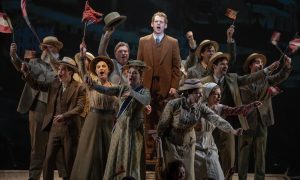Sport and dance have long been regarded as competitors but it may just be that they are on the same team these days.
By Paul Ransom.
Remember all that stuff they told you about how jogging or playing basketball was bad for you? Well, suppose it wasn’t?
Since the 1980s huge advances have been made in sport specific training, recovery programmes and injury management and it is clear now that much of this new expertise is in the process of crossing over into the dance world. Indeed, the old chasm between sport and dance is rapidly narrowing.
Physical therapist Michael Heyman is perhaps emblematic of this change, working as he does in both elite sport and professional dance. Heyman not only runs the rule over star footballers in the Australian Football League, but consults with the world renowned Australian Dance Theatre (ADT).
“I think that dance and sport are more similar than they are different. If you look at both there are technical aspects, the skills that need to be learned, the psychological aspects of performance and even nutritional requirements,” he argues. “The wise old heads say that you shouldn’t go jogging because of the aesthetic impacts but I think that’s a flawed idea because developing fitness and general athletic ability can really enhance technique.”
Over at the Australian Ballet, principal physical therapist Susan Mayes suggests that although sport does pose some risks to a dancer it can also be highly beneficial. “One of the main considerations when recommending an elite dancer’s participation in sport is the risk of injury,” she begins. “At the elite level, dance is their career, their livelihood and their dream and any injury may be a potential risk to their performance.”
However, the positives are significant. “Having said that,” she continues, “cross training and different activities can provide a benefit in terms of general fitness and challenge which can enhance the dancer’s wellbeing.”
Michael Heyman is even more specific in his choice of sporting activities for dancers. Citing gymnastics and figure skating as having rather obvious parallels, his best advice is tennis. “It’s great,” he enthuses. “Burst of power, volley, run, stop, go get the ball, reset, go again. In terms of the energy systems and the amount of physical work, they’re actually not too dissimilar.”
From up on stage ADT dancer Larissa McGowan is well positioned to offer a performer’s perspective, having grown up playing a variety of sports, which ultimately nurtured an ambition to compete in athletics at the Olympics. However, once she made the switch to dance, certain changes were required.
“I kept running through my college training days and continued once joining ADT,” she recalls, “but I had to start to pull back a bit as it shortened my hamstrings slightly making it harder to pull up the leg in ballet. It also bulked up my thighs and gluteus which, when too big, hamper some rotation range.”
McGowan would of course be participating in Michael Heyman’s regular forty minute circuit training sessions at ADT headquarters; a routine he has developed specifically to meet the bend, stretch and twirl needs of the dancer.
“In sport you might have key requirements like strength, power, flexibility and balance but a lot of them are also the key requirements for dance,” Heyman declares. “One way of thinking of dancers is as aesthetic athletes. If you’re backing up night after night the physiological and fitness aspects are just as important as the skill component. You can’t keep doing the dance unless you’re fit enough and strong enough to do it.”
Susan Mayes is happy to concur, noting that each show comes with its own set of physical requirements. “Gym programmes should be individualised so that both male and female dancers focus on specific areas which will be loaded during the performance season,” she says simply. “At The Australian Ballet we analyse the potential injury risks of the upcoming repertoire and design specific exercise programs for the dancer’s role in a particular ballet.”
However, beneath the particulars of exercise regimes and sporting preferences there is one clear synergy. According to Mayes, “The worlds of elite sports and dance are exceptionally competitive, due to the level at which they perform and the relatively small numbers of professional positions available. Dancers are very often perfectionists; and with this quality comes a great competitive nature, and like athletes, they strive to achieve a great performance every time they’re onstage.”
Larissa McGowan is certainly glad to have grown up doing sport. “My sporting background has sculpted my body and strengthened it over the years, allowing me to continue dancing for the past ten years with only minor injuries.”
In conclusion, it appears that much of the remaining sport/dance schism is largely cultural, a leftover from old ways of thinking and doing. As Michael Heyman observes, “All sports and activities have a certain culture around them. Footballers behave in certain way because footballers in the past behaved that way and for dancers it’s no different.”
The message, it seems, is quite clear. Dancers wishing to maintain a level of performance and reduce injury can be well served by targeted fitness training and even the odd set of tennis. You might even say that the ball is in their court.
Photo: © Stephen Coburn | Dreamstime.com















